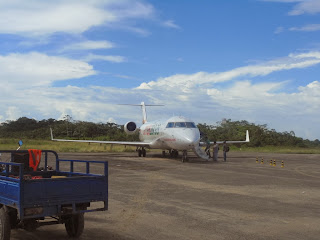Saturday, December 7
Hostal Sol Andina, La Paz
Hostal Sol Andina, La Paz
Here I am, sitting on a bed with two
thick and heavy lama wool blankets, contemplating if I should slide
my feet in to warm them up when this morning just after sunrise
rivulets of perspiration were already running down my back on my way
to the 'Amaszonas' airline office in downtown Rurrenabaque.
We left La Paz only four days ago, but
it felt like a small eternity when we returned this morning, so far
removed from the by now familiar highland scenery had we been. We had
found out about the Pampas tours from the travel agent conveniently
housed in the lobby of our hostel and had made a quick decision to
choose this as one of our Bolivia experiences.
On Tuesday evening we boarded the small
plane from Air Amaszonas at 4,060m above sea level at the La Paz
airport, and forty-five minutes later we touched down at an
altitude of 229 m in Rurrenabaque. To reach this small town northeast
of La Paz by road takes twenty-four hours on difficult roads winding
through mountains and, later, jungle. Most people prefer to use one of
the small aircraft of Air Amaszonas or Tam that come in three times a
day. Pleasant as this option is, it, too, is not without challenges:
often enough flights are cancelled because of poor visibility. There
was no problem for us, however, and we soon enough stepped out into
the sweltering heat of the lowlands.
 |
| Touching down in Rurrenabaque |
 |
| The airport - all of it |
 |
| Airport shuttle |
To our surprise we were greeted by a
representative of 'Dolphin Tours', and after the incredibly
unorganized unloading of the luggage of this small group of
passengers at the smallest airport I have ever seen we headed into
Rurre, as it is called locally, and were delivered to our hostel.
The next morning we shouldered our
packs and walked the few blocks to Dolphin Tour's office. It seems
there are hundreds of motorbikes in this town of about 14,000 in the
middle of nowhere. Men, women, teenage girls and boys, families of
four squeezed together, a husband with his stately wife perched
sideways behind him on the seat – there is a constant up and down of
motorcycles in the streets, honking, swerving around obstacles and
pedestrians. Shoulder to shoulder stand the little stores, restaurants, and bars, in the main street
for tourists, one street removed mostly for the locals. Mango trees, heavily laden with still-green
fruit, give welcome shade, and most of life takes place in front of
houses and shops.
During the night it becomes quiet for a
while, but by sunrise life picks up again, albeit at a more leasurely
pace than in the bigger (and cooler) centres.
We had no clear idea what expected us
in these next three days, only the broad outlay of information we got
from the travel agent and our brochure, so all we knew was that we'd
spend three days in the pampas, the extensive grasslands, and that
we'd be housed in a lodge along the river Yacuma, a tributary of the
Río
Beni flowing through Rurrenabaque.
There is one tour operator beside the
next along that stretch of street, and everywhere tourists were
waiting to be picked up for their sojourn into the wetlands. Nearly
all of them were backpacker type young people, hardly anyone seemed
to be much over thirty – why, I have no idea. Interestingly,
however, the only two people joining us at Dolphin didn't fit that
category: André from Belgium was in his mid seventies, and José
Luis from Spain in his early fifties – we could easily have been
everybody else`s parents.
Shortly after nine Joaquin, our driver,
was ready to leave. Our bags and some supplies meant for the lodge
were loaded into a white Toyota four-wheel drive seven-seater, and we
were headed north along the bumpy road leading out to the airport.
Soon after we passed it the semi-paved road abandoned all pretense of being anything but
a gravel road, and not a very good one to boot.
The sun was shining
now, but it had rained heavily the few preceding days and in some
spots deep ruts were still filled with water. With exceptional skill
Joaquin negotiated big rocks and deep holes, changing lanes as
necessary, getting the speed up to eighty kilometres per hour for
short stretches before encountering yet another area where
manoeuvering was difficult. Trucks, buses, motorcycles and a few
vehicles like ours, loaded with tourists headed for adventure,
shared the road with white, grey and brown Brahma cows on their way
to a different pasture, herded by cowboys on small, tough horses.
Once we passed a team of big oxen hitched to a wagon.
We passed the small town of Reyes, then
stopped for a short break at a shack/restaurant in the middle of
nowhere, the half-way point of our car ride. After about
two-and-a-half hours we had a pre-ordered lunch in Santa Rosa, a neat looking town
of maybe five thousand people with businesses and paved streets,
and only ten minutes from there our road travel came to an end. It was time to say goodbye to Joaquin and change the means of transportation.



No comments:
Post a Comment